If you tracked the rise of influencer marketing, it would resemble a rocket launch. In 2022, influencer marketing reached a new record $16.4 billion in industry size. And even that’s just scratching the surface. 17% of marketers went into 2023 with plans to invest in influencer marketing for the first time.
But not all influencer marketing is made alike. Big, celebrity-style endorsements can have completely different effects than smaller, niche audiences. And if you’re starting out with influencer marketing for the first time, you might not have a giant budget yet.
To solve that, you can turn to the tiniest edge of the influencer galaxy: nano-influencers.
Nano-influencers come with lots of advantages. They’re high-engagement, low-cost, and often build authentic relationships with their followers.
But who are they? Why are their engagement rates so high? And more importantly, how can you leverage them in your next creator campaign?
In this guide, we’ll drill down beyond the world of micro-influencers and into the world of the smallest influencers around. Let’s explore what nano-influencers are up to…and how you can engage them for influencer marketing success.
ADVANCED GROWTH INSIGHTS
Every couple of weeks we send out new influencer prospects, marketing tips, and pro campaign tactics. It's free. No spam. Unsubscribe whenever you want.
What Are Nano-Influencers?
Nano-influencers are the smallest category of influencers if you rank them by follower count. Some people, like Neal Schaffer, define them as having 1,000-10,000 followers. But you’ll find this is a common definition of micro-influencers, too.
But given that a nanometer is smaller than a micrometer, nano-influencers typically refer to the smallest influencers you can find. Someone with 997 subscribers on YouTube, for example, is a classic nano-influencer.
You might scoff. 997 followers? How is that influencing?
Simple: nano-influencers have a unique appeal. With follower counts that small, their focus is tight. And their engagement numbers are often through the roof.
For example, nano-influencers with fewer than 5,000 followers have the highest engagement rates at 5%. Compare that to celebrity influencers, whose engagement falls to 1.6%.
In other words, nano-influencers can give brands great bang for the buck. And if influencers charge by the follower count, it means you don’t have to have the influencer marketing budget of a Fortune 500 company to get started.
People also tend to trust nano-influencers. On social media, you might not expect a reply from Kim Kardashian and her 100,000,000 followers. But it’s normal to get a reply from a nano-influencer.
And given that people turn to influencers for trust, that kind of engagement is worth its weight in gold.
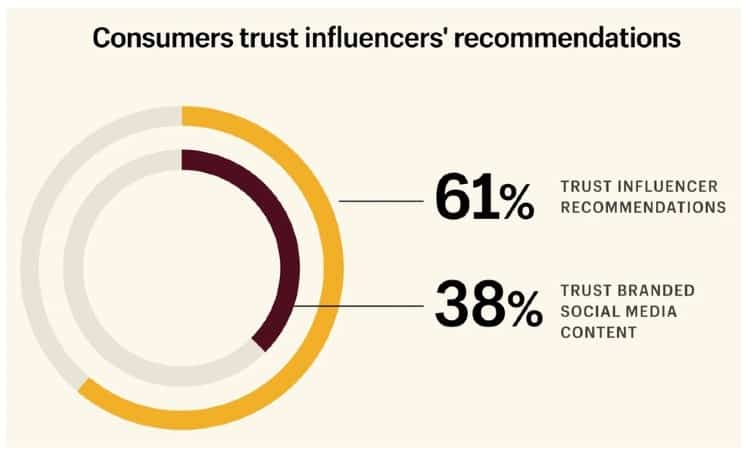
5 Benefits of Working with Nano-Influencers
1. High engagement rates
To recap: 61% of people trust influencer recommendations. Nano-influencers have the highest engagement rates at 5%. It follows that working with nano-influencers is like “buying” trust for your brand.
2. Authentic followers
When an influencer has a million followers, there’s no way to verify the authenticity and enthusiasm of each of those followers. With nano-influencers, you can browse their followers yourself. With a quick scan, you can see if they’re your target market.
Even better, nano-influencers with fewer followers will tend to have more of a back-and-forth relationship with their audience. Their marketing feels more like a dialogue than a soliloquy. The result: more engagement from followers.
3. Niche certainty
A nano-influencer typically has a well-defined niche. Let’s say you’re an athletic supplements brand. Hiring a reality TV star might overlap with your audience. And it might not.
But if you work with a nano-influencer who only does sports supplement reviews, you know you’ve hit your market.
4. The ability to test
A nano-influencer is almost always the most affordable option in influencer marketing. This means you can test a campaign—or multiple campaigns—before you scale it to new heights.
Maybe instead of working with a macro-influencer, you work with five nano-influencers to see which style of campaign creates the most engagement.
5. Enhanced trust
Speaking of trust, how often do you trust a celebrity endorsement? Data suggests people find nano-influencers more relatable because they’re more like Internet friends than celebrity cults of personality.
And given that 61% of people trust influencer recommendations, we can only assume those trust numbers are higher when your influencers are small.
How to Find Nano-Influencers
Clearly, nano-influencers have a lot of value in the world of influencer marketing. But given that “nano-” prefix, they also come with one teensy challenge. By definition, they can be harder to find.
In some cases, a nano-influencer might not even consider themselves an “influencer” quite yet. That word has connotations of a big audience, and many nano-influencers have yet to monetize that audience.
How do you find influencers with a tiny audience—yet who are open to brand collaborations? Here are a few ways you can start discovering the diamonds in the rough:
#1 Organic search
Turn to old friends like Google and Bing. Run online searches for nano-influencers, adding your specific niche as a keyword.
This is definitely not the best way to find an influencer right away. There are going to be hidden gems that don’t make the top results of Google. After all, if they had larger audiences, they probably wouldn’t be so hidden.
But you can use organic search to start compiling a list of potential influencers. Here are some tips:
- Get specific. If you use vague keywords, you likely won’t find nano-influencers. You’ll find mega-influencers. For instance, “kitchen organization tips on YouTube” is much more specific than “top cooking influencers.” The latter is more likely to plop you down in the land of celebrity chefs.
- Avoid “top influencer” lists. These roundup-style lists tend to default to the writer’s own organic research, which means they’re also finding mega-influencers. You might find some people you haven’t heard of on these lists, sure. But it will feel counterproductive when you find out those influencers have 50,000 followers.
- Try some non-influencer influencer keywords. Your instinct with Google will be to use keywords like “influencer.” But nano-influencers typically don’t talk about themselves as influencers. They might use key phrases like “open to collaboration” or “seeking sponsorship.” When you use organic search, make sure you’re speaking their language.
Advantages and disadvantages of this approach: Organic search gives you 100% control over who you reach out to. But with control also comes more responsibility.
You’ll have to be the one to verify whether a nano-influencer is the right choice. And you’ll have to be the one to decide whether their quoted engagement rates are legitimate.
#2 Social search
The search functions on platforms like Twitter and Instagram don’t have the complex algorithms of Google and Bing. But they are a more direct way to search for active users who might fit your influencer marketing criteria.
Here are some tips for using social search to identify your nano-influencers:
- Explore hashtags. Browse a few influencer posts in your niche. Pay attention to the hashtags they use. Chances are, aspiring nano-influencers are using many of the same hashtags. What’s great about this method is that it helps you identify nano-influencers who are open to influencer marketing with you.
- Double-check for activity. Let’s say you find an influencer with 999 followers, high engagement, and a niche that overlaps yours. Great! But what if they haven’t posted in six months? Unfortunately, recent activity is a major indication of whether your nano-influencer still has the kind of pull with their audience.
- Take their “engagement” temperature. You can’t get precise engagement numbers with social search. But you can check out other public information, like views and likes. See what kinds of engagement rates they get for their post. With a little Googling, you can identify typical platform engagement rates and measure whether your nano-influencer has an outsized audience impact.
Social search helps you find authentic connections. But it can be a bit time-consuming. And once again, you may have to do your own verification.
Sometimes, you might find out a nano-influencer is poor at driving engagement, but only after your campaign is already over.
#3 Influencer platforms
Influencer platforms give you a few handy shortcuts. For starters, you don’t have to run time-intensive searches. You can simply browse a platform, sort by “follower count,” and voila: you’ve got a list of nano-influencers.
But how do you whittle down your list to find the most appropriate influencers for your campaigns?
Use those filters. Platforms use search filters for a reason. You can quickly filter out influencers with too many followers for your nano-influencer campaigns, for example. Using Afluencer, you can also filter for specific niches.
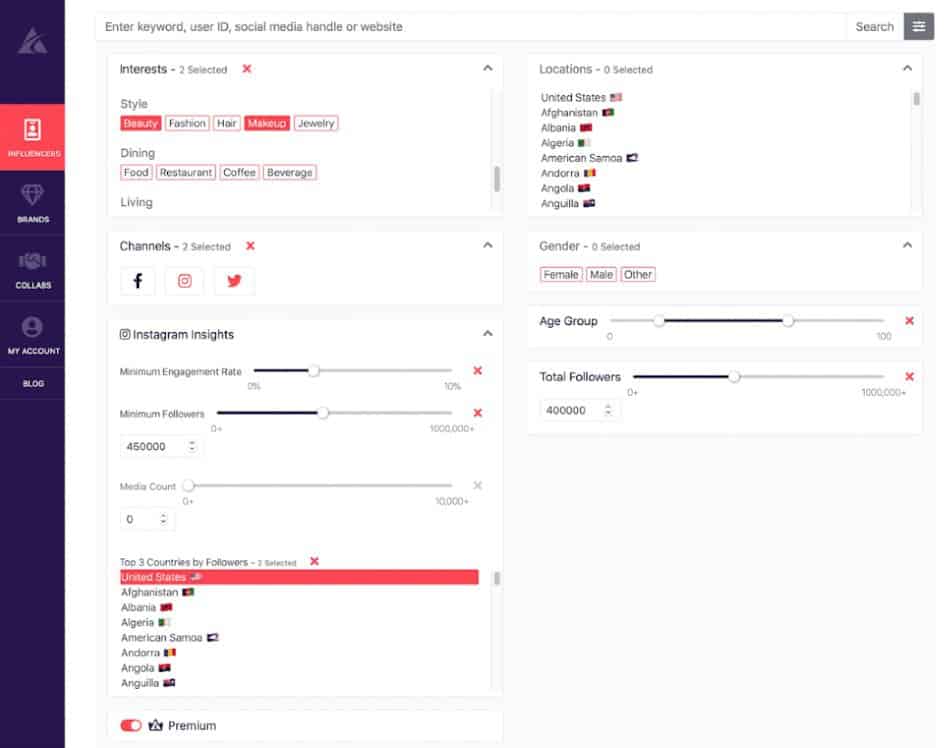
For example, let’s say you want someone in fashion blogging, but not in skin care. A large-scale influencer might dabble in both. But you can filter out “skincare” for your apparel brand and find nano-influencers with hyperfocus within your niche. You can also sort by geographical location for location-specific campaigns.
Sort by statistics, like engagement rate. This will help you align your campaign goals with the right influencer. For example, let’s say that your goal is to see which campaign drives the most engagement. Because platforms like Afluencer include statistics to help you measure which influencer might work best, you can sort by these stats, choose the top two, and essentially run a “test” campaign with each. Watch which campaign resonates the most, then double down on that campaign the next time you work with an influencer.
A platform brings influencers to you, including information about which platforms they use, their audience size, their engagement rates, their location, and the niches they serve. There’s no guesswork here, no intense research. Using filters, you can easily whittle down your top choices until you find an influencer who might be perfect for your brand. Platforms like Afluencer serve as great introductions to influencers with tiny niches who can be perfect for your campaign.
#4 Agencies
Agencies are more common these days, rising to meet the demand of companies who don’t have time to meet every influencer themselves. A marketing agency can fill that void, making introductions between companies and influencers who might be a match.
Agencies can also help with managing the influencers, driving the creation of new influencer content, and analyzing the success of each campaign. Here are some ways to ensure you get the most out of your agency:
- Take your time. Be careful here. Select an agency with as much thoughtfulness as you would approach an influencer. Once again, it’s about finding the right fit. What’s most important to your brand? Keep that question in mind when you talk to agencies about the work they can do—and whether it lines up with your goals.
- Ask for real-world results. A good agency can show proof when a campaign has worked with nano influencers in the past. Ask for case studies or other real-world results the agency can provide. At the very least, this should give you a baseline representation of what to expect. But remember that the best case studies aren’t always representative of future results.
There are plenty of conveniences when working with an agency. But in exchange, you’ll have to give up some control over the agency’s work.
How Much Should You Pay Nano-Influencers
The chief advantage of nano-influencers is they charge far less than everyone else. Fewer followers mean you spend less money, even if engagement rates per post are much higher. It’s the best bargain in influencer marketing.
That may be one reason so many people (approximately 49% of marketing respondents) keep their influencer marketing to small influencers, to begin with.
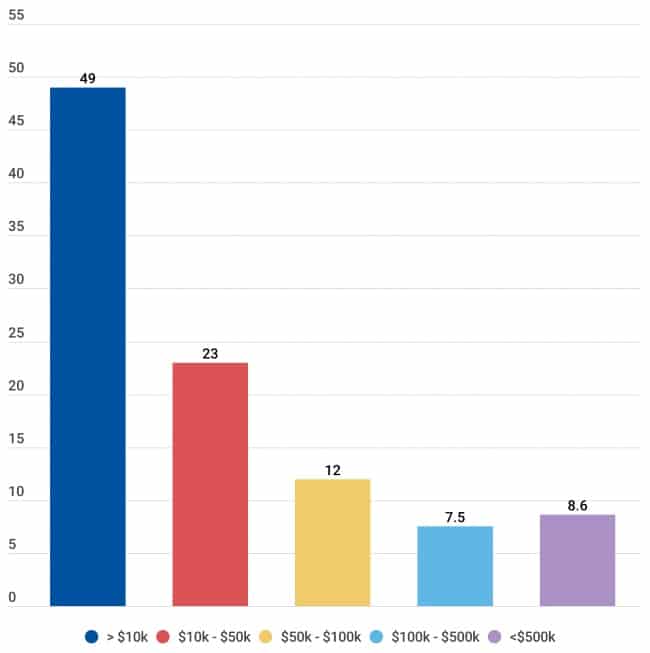
What can you expect to pay? It will vary based on influencer and platform types. But here are some ballpark figures you can use.
- According to Andrew Macarthy, an Instagram rate sheet for Instagram posts in 2022 said to expect a rate between $10-$100 for nano-influencers between 1,000 and 10,000 followers.
- We also found that Influencer Marketing Hub confirmed this typical rate for nano-influencers on Instagram. They pointed to similar numbers for other platforms as well: expect $20-$200 per post on YouTube, $5-25 on TikTok, $2-20 on Twitter, and $25-250 on Facebook.
- Additionally, a source at Later filled in some details for longer-term pricing packages with Instagram influencers. For instance, one mention for story packages with 15,000 average viewers (more than the average nan influencer) would cost $300. At two cents per view, you might expect a nano influencer with ~1,000 average views in Instagram stories to only cost around $20 per post.
- According to eMarketer, nano-influencers (this time defined as 500-5,000 followers) will typically expect $100 per Instagram post, $114 per Instagram video, and $43 per Instagram story.
You’ll notice that this provides a ballpark figure for what you can expect for a nano-influencer post. But there’s still plenty of wiggle room there; between $25 and $250 on Facebook, for example. How do you know what you should pay?
There are a few factors that should weigh into how much you’re willing to offer:
- Engagement rate: When you’re thinking about a specific influencer, you’ll have a frame of reference for what kind of engagement you should expect. For instance, someone with 1,000 followers who often gets 4% engagements should provide about 40 engagements. The question is: what are you willing to pay for that?
- Style of content: Do they put together big-time videos that require a lot of production? Or do they typically make small, easy-to-post hits for their audience?
- Exclusivity: Exclusivity isn’t always a consideration for larger influencers. They don’t always like to give up potential revenue from other sources in exchange for exclusivity. But a nano-influencer might be willing to consider it for a premium.
- Length of campaign: The length of the collaboration agreement can impact the rate. One advantage of using nano-influencers is that you can leverage a smaller audience to arrange a longer-term arrangement, which builds up brand recognition and trust.
Top Nano-Influencers on Afluencer
If you’re looking for nano-influencers, you can browse the Afluencer directory of influencers for a good head start. But we decided to highlight some of the nano-influencers in that directory to give you an idea of the types of people—and the styles of content—you can expect to encounter.
Shawnea Paschall

With around 3,000 followers on Instagram, Shawnea Paschall is a model and influencer who highlights sponsored products for her audience. Her lifetime engagement rate of 9.6% is through the roof, highlighting the spectacular numbers you can sometimes expect to see when working with influencers who have smaller, niche audiences.
Jai Cerise
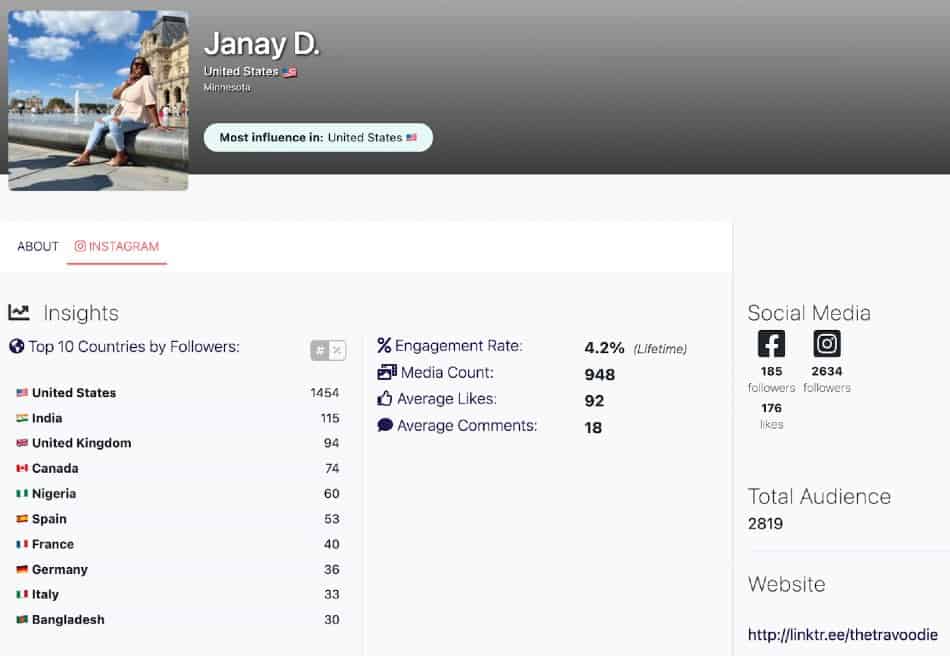
A self-described “travoodie” (travel + foodie) with a nano-influencer following on Instagram at 2,619 followers, Jai’s 4.35% lifetime engagement rate comes from an average of 93 likes per post.
Laura Flanary
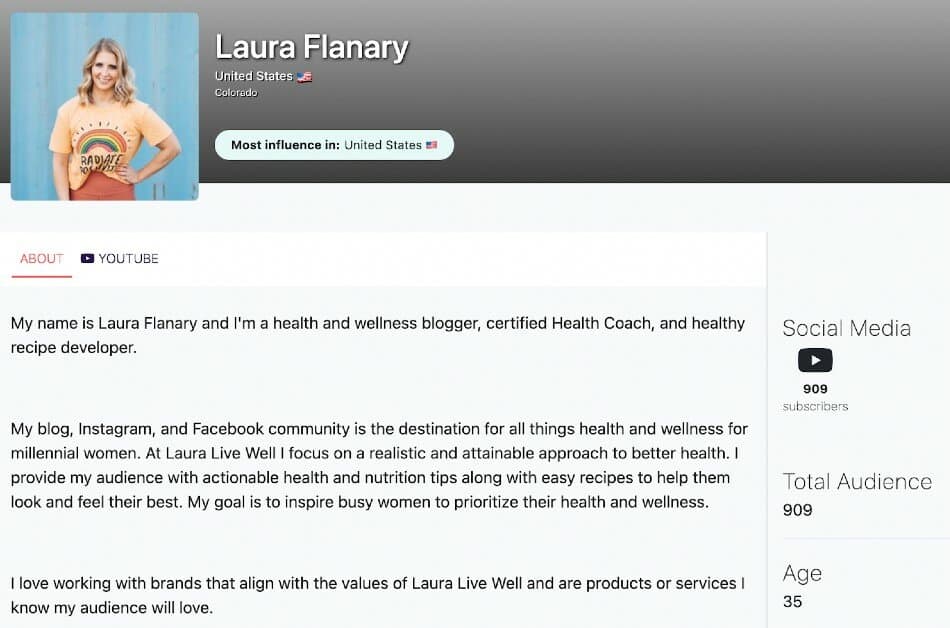
A YouTube influencer with around 900 subscribers and a 3.31% lifetime engagement rate, Flanary comes from the health and wellness space. You can find her under “Laura Live Well” on YouTube. Her active history of YouTube consistency, with over 180 lifetime videos, highlights that she’s in it for the long haul.
Megan Rasmussen
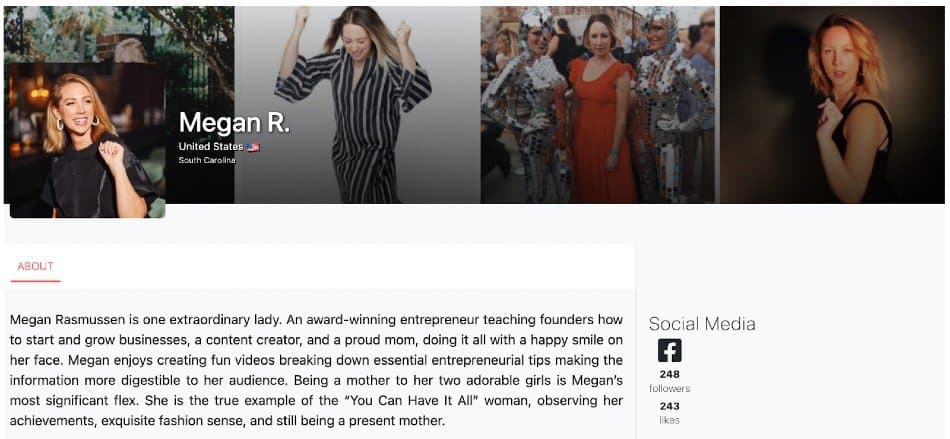
Primarily on Facebook, Rasmussen is an entrepreneurial blogger and creator with a small but tight following in her Facebook community.
In fact, she likes it that way, deactivating your ability to view the community until you join. At just 248 followers, she cultivates a “VIP” atmosphere among her potentially influential followers who are thinking big in the world of entrepreneurship.
Solomon Rivers
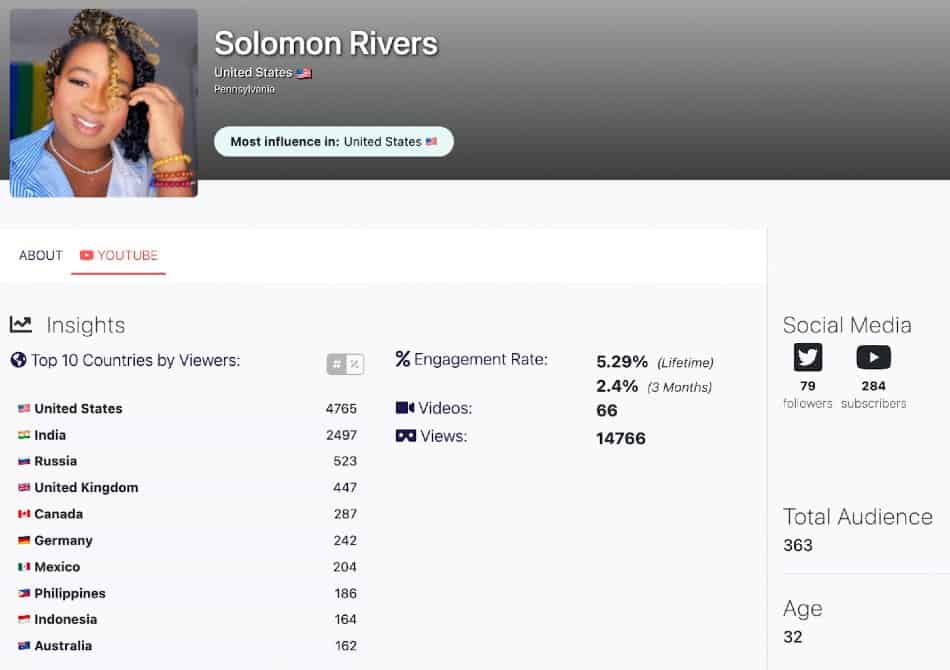
Loving real estate, finance, and makeup. Nano-influencers often have fun overlaps between niches that make them entirely unique. That’s Solomon Rivers, who has 300+ subscribers across YouTube and Twitter.
Solomon has been posting regularly and building an audience, which is when it can be fun for a brand that wants to grow along with an influencer.
Engaging the World of Nano-Influencers
What’s the most fun you can have as an investor? Finding that penny stock that skyrockets to the moon. It works the same in influencer marketing.
There are plenty of diamonds in the influencer marketing rough out there. They bring high engagement, and high niche expertise, and often have communities full of few but rabid fans. And there’s no limit to how many nano-influencers you can engage. They represent the ideal starting point for any influencer marketing campaign.
Want to start it yourself? Install the Afluencer app for Shopify here.
Can We Hook You Up With More Influencers & Creators?
Join Afluencer for full access to our directory of outstanding talent. Sign up for a 30-DAY free trial.
FREE TRIAL